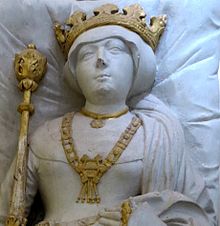Gertrude von Sulzbach
| Gertrude of Sulzbach | |
|---|---|

Effigy, Ebrach Abbey Church
|
|
| Queen consort of Germany | |
| Tenure | 7 March 1138 – 14 April 1146 |
| Predecessor | Gertrude of Comburg |
| Successor | Adelaide of Vohburg |
| Born |
c. 1110 Sulzbach Castle, Bavaria |
| Died | 14 April 1146 (aged 35–36) Hersfeld Abbey, Franconia |
| Burial | Ebrach Abbey |
| Spouse | Conrad III of Germany |
| Issue |
Henry Berengar Frederick IV, Duke of Swabia |
| House |
House of Hohenstaufen (by marriage) |
| Father | Berengar II of Sulzbach |
| Mother | Adelheid of Wolfratshausen |
Gertrude of Sulzbach (German: Gertrud von Sulzbach; c. 1110 – 14 April 1146) was Queen consort of Germany from 1138 until her death, as second wife of the Hohenstaufen king Conrad III.
She was a daughter of the Bavarian count Berengar II of Sulzbach (c.1080–1125) and his second wife Adelheid of Wolfratshausen (d. 1126).
Berengar was a son of Count Gebhard II of Sulzbach (d. 1085) and Irmgard of Rott (d. 1101). Irmgard was a daughter of the Bavarian count palatine (Pfalzgraf) Kuno I of Rott, founder of Rott Abbey, and his wife Uta. There is a theory identifying her mother as a daughter of Count Frederick III of Andechs-Diessen, however, this is not confirmed by primary sources. Countess Irmgard is mentioned as the founder of the Augustinian chapter in Berchtesgaden. There is mention of her marrying twice but the identity of her second husband is disputed. The most likely candidate is Count Kuno II of Horburg.
Gertrude's grandfather Gebhard II is generally considered identical with Count Gebhard I of Sulzbach, the first person known to have used this comital title. On 28 November 1043, Gebhard was granted property by charter of King Henry III of Germany, whereby his mother is mentioned as "Adalheit". The Genealogische Tafeln zur mitteleuropäischen Geschichte genealogy (1965–1967) by Wilhelm Wegener identifies her as Adelaide of Susa (d. 1091); his father therefore being Duke Herman IV of Swabia. This theory has gained some acceptance. However Charles Cawley notes that this would place Gebhard's birth c. 1037–1038. In order for him to have grandchildren by the 1080s, "this would require a succession of teenage bridegrooms which seems improbable." Wegener theorises the wife of Gebhard I to have been a daughter of Berengar, Count in the Bavarian Nordgau. He suggests that Sulzbach was part of her dowry. Cawley considers the theory to stand only on "the transmission of the name Berengar into her husband's family." Otherwise no connection between the families is known to exist.
...
Wikipedia
